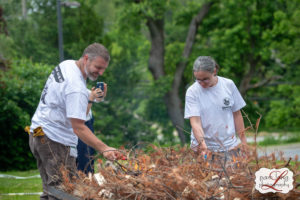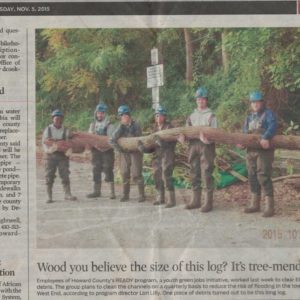An Environmental Restoration Workforce for the Future
by Lori Lilly, Howard EcoWorks
I lead an organization called Howard EcoWorks (EcoWorks) in Howard County, MD. We empower communities and diverse workforces to respect and restore our natural systems for future generations. For the first several years, we focused on one thing – building rain gardens. As our relationship with the County, our primary funder, grew, we started performing maintenance on the County’s stormwater and stream restoration practices. Our organization and its programs have been growing quickly and succeeding in many ways. However, I have also witnessed our County seat, Ellicott City, devastated by a series of freak, high intensity storm events. With each successive storm, my professional assumptions about how to restore a watershed, and my organization’s role in that, have changed.
We’re hearing a lot about “resiliency” lately, and for good reason. However, we’re going to have a hard time building resilient communities and watersheds without being more flexible and adaptive with the current tools that we have in the toolbox. I will provide an example from my own experience at EcoWorks.
The EcoWorks green jobs programs have been funded through the County’s stormwater utility fee. This is an incredible model for other communities — if you’re looking for public support to build and maintain green infrastructure projects, look for models or opportunities to get money in people’s’ pockets to do it (with assistance from a non-profit like EcoWorks). This is a win-win for all parties!
After the 2011 flood in Ellicott City (a lesser known flood that dropped 7 inches of rain in three hours), the County commissioned a stream corridor assessment.[1] This study found that debris blockages were one of the contributing factors for the flood and recommended that a debris maintenance program be instituted. Step in “watershed re-storer” Lori with a workforce at her disposal. I advocated to the County to allow our crews to undertake such an effort. The County agreed and so it began.
Initial debris removals took forever, as these channels hadn’t been maintained for decades or perhaps ever. Fast forward to the July 31, 2016 flood that unleashed 6.6 inches of rain in 3 hours(!). Being experienced now with debris management, the County asked us to help with clean-up. We certainly weren’t first responders, but we were in the channels within a week or so when the town was still shut down. I pulled crews off a huge rain garden that they were working on in Columbia for this “special ops.” We felt very good about the support that we were able to provide to the community and the County. And then the same thing happened again on Memorial Day, 2018, but this time with 8 inches in 3 hours. If you see a trend line here, it is certainly an alarming one.

Crew after a long, hot day of removing debris and trash from the stream channels after the 2016 flood. Photo: Lori Lilly

The power of people. Crews remove a steel girder from the stream channel after the 2016 flood. It would’ve been extremely difficult and costly to get a crane into this location to remove the girder that was poised above the Ellicott Mills culvert. Photos: Lori Lilly.
The 2011, 2016 and 2018 floods that devastated the town have raised questions for me in regards to the environmental restoration goals for the Tiber Hudson watershed draining to Old Ellicott City — and really watersheds everywhere. These issues include the shrinking timeframe within which the goals can be achieved, the silos in which regulations and funding function, the flexibility that is needed at a local level to deal with a global problem, and how we can drive economies now to meet needs that we can maybe anticipate for the future.
When we are constantly seeing and hearing about the loss and decline of species — from birds, amphibians, mussels, insects and more — and experiencing first hand an increase in the frequency and intensity of disasters and hazards — from floods, droughts, fires and more — what is a realistic timeframe that we think we actually have to get any of this under control?
I started down the path of trying to “restore a watershed” based on a professionally-influenced process and framework for the Tiber Hudson watershed. I have a strong tie to the community and ability to work at the grassroots level. I have knowledge and experience to find funds and direct resources appropriately. But three disasters later, it seems like we need to reevaluate the goals and objectives, and the best way to get there.
To my knowledge, clearing streams of debris doesn’t give an MS4 credit for impervious surface treatment or TMDLs. However, we have this severe stormwater management problem that is exacerbated by climate change. This is where I think hazard mitigation planning and water quality need to meet, and where state, local and federal governments can find more synergy in resource allocation, programs, funding, and technical assistance. The outcome would be to better support communities facing hazards being intensified by a problem outside the control of local jurisdictions.
Those advocating for actions to address the climate crisis, and many of the foundations that are funding climate action, are largely focused on fossil fuels and energy. I agree – resources certainly need to be allocated to energy and emissions. But we also need more attention and resources allocated to natural climate solutions, and we can start where these solutions overlap with MS4 and TMDL goals. Being in the professional world that I inhabit, and with the power of people at hand, my brain goes to tree planting and soil restoration. One especially promising approach is the use of biochar amendments to enhance carbon sequestration in addition to runoff reduction and water quality.
An economy of jobs can certainly exist within the space of natural climate solutions, and if we add in adaptation and mitigation for natural hazards and food security, we would truly be building an environmental restoration workforce for the future.
Thoughts or follow-up? Feel free to email me at llilly@howardecoworks.org.
Howard Ecoworks website: https://www.howardecoworks.org/

Making biochar at a Soak It Up community event in Ellicott City, May, 2019. In the background – biochar research test plots being conducted in partnership with the University of Delaware with funding from the National Fish and Wildlife Foundation. Photo: Pam Long Photography
[1] The study has been taken offline but a very similar study was completed by the same consultant after the 2016 flood and that can be found here: https://www.howardcountymd.gov/LinkClick.aspx?fileticket=jsvBPIHL1F8%3d&portalid=0

